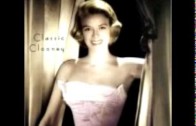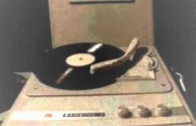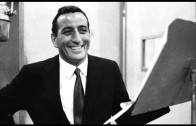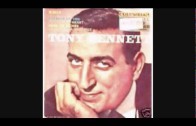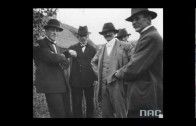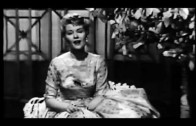Before the rock & roll revolution, Rosemary Clooney was one of the most popular female singers in America, rising to superstardom during the golden age of adult pop. Like many of her peers in the so-called „girl singer” movement – Doris Day, Kay Starr, Peggy Lee, Patti Page, et al. – Clooney’s style was grounded in jazz, particularly big-band swing. She wasn’t an improviser or a technical virtuoso, and lacked the training to stand on an equal footing with the greatest true jazz singers. However, she sang with an effortless, spirited swing, and was everything else a great pop singer of her era should have been. Her phrasing and diction were flawless, and her voice was warm, smooth, and relaxed; moreover, she was a sensitive and emotionally committed interpreter of lyrics. Some of her biggest hits were dialect-filled novelty songs, like her star-making breakthrough „Come On-a My House” from 1951, but she generally preferred to tackle more sophisticated fare, and recorded with numerous duet partners, jazz orchestras, and top-tier arrangers. Changing tastes and various personal problems conspired to stall her career in the ’60s.
Clooney was born May 23, 1928, in Maysville, KY. Her childhood was a difficult one; her father was an alcoholic, and her mother’s job required extensive traveling, so Clooney and her siblings were shuffled back and forth between both parents and assorted relatives. When Clooney was 13, her mother remarried and moved to California, taking Clooney’s brother Nick (later an actor and TV host) and leaving Rosemary and her younger sister Betty in the care of their father. At first, he supported the girls by working in a defense plant, but his troubles got the better of him, and he abandoned them at the end of World War II. At first, Clooney and her sister supported themselves by collecting cans and bottles, and entered amateur talent contests as a singing duo (Rosemary had grown up idolizing Billie Holiday). They were saved from poverty (and likely eviction) when they successfully auditioned for a Cincinnati radio station later in 1945.
Billed as the Clooney Sisters, Rosemary and Betty gave weekly radio performances until they were discovered by bandleader Tony Pastor. By the end of 1945, the girls had joined his orchestra as the featured vocal attraction — which was rapidly becoming a necessity in the postwar era. In 1946, Rosemary cut her first solo record, „I’m Sorry I Didn’t Say I’m Sorry (When I Made You Cry Last Night),” but didn’t begin to work as a solo artist until 1948, when Betty decided to stop touring with Pastor and return to Cincinnati. Clooney stayed with Pastor for another year before heading to New York in 1949 and signing a solo record contract with Columbia.
Most of Clooney’s earliest records for Columbia were children’s songs, but in 1951 she began working with producer/A&R man Mitch Miller. As he did with many other artists, Miller pushed Clooney to record novelty numbers, specifically an Italian-dialect song called „Come On-a My House” that had been co-written by Armenian-American cousins William Saroyan and Ross Bagdasarian (the latter would go on to fame as creator of the Chipmunks). Clooney hated the song and held out for weeks before finally giving in. Despite her lifelong distaste for it, „Come On-a My House” was a huge success; it sold over a million copies and topped the charts in 1951, instantly making Clooney a household name.
Over the next few years, Clooney alternated between hot big-band swing and the light novelty fare Miller insisted upon, though she much preferred the former. She was wildly popular in the years leading up to rock & roll, scoring hit after hit: the chart-toppers „Half as Much,” „Hey There,” and „This Ole House”; the Italian-style tunes „Botch-a-Me (Ba-Ba-Baciani Piccina)” and „Mambo Italiano”; and several other cornerstones of her repertoire, including „Tenderly” and „If Teardrops Were Pennies.”
Clooney also continued to record, though with diminishing success thanks to the advent of rock & roll. Still, her repertoire was growing more mature, as she recorded with Duke Ellington (the 1956 album Blue Rose) and Benny Goodman, and also tried her hand at country standards and Broadway show tunes. Her final Top Ten hit was 1957’s „Mangos,” and the following year, she parted ways with Columbia and moved over to RCA, where she debuted with the well-received Bing Crosby collaboration Fancy Meeting You Here. She went on to record for MCA, Reprise, Coral, and Capitol during the ’60s as well. ~ Steve Huey, All Music Guide
PLEASE NOTE: I divided my uploads among multiple channels, Bookmark this link in your browser for instant access to an index with links to all of John1948’s oldies classics. LINK: http://john1948.wikifoundry.com/page/John1948%27s+Youtube+Index
